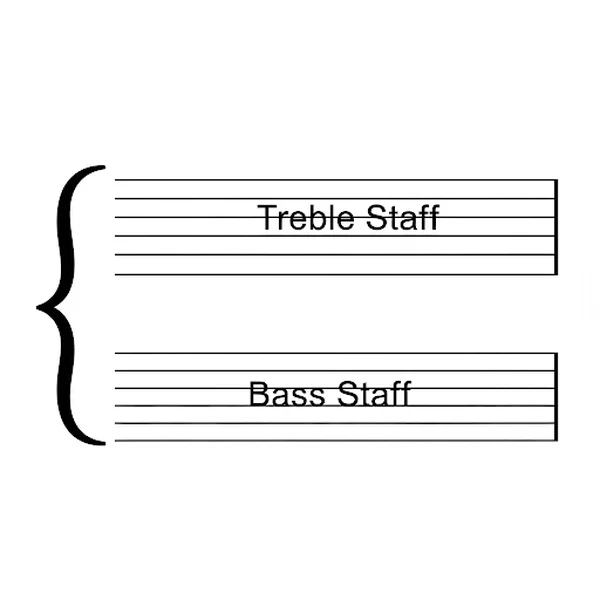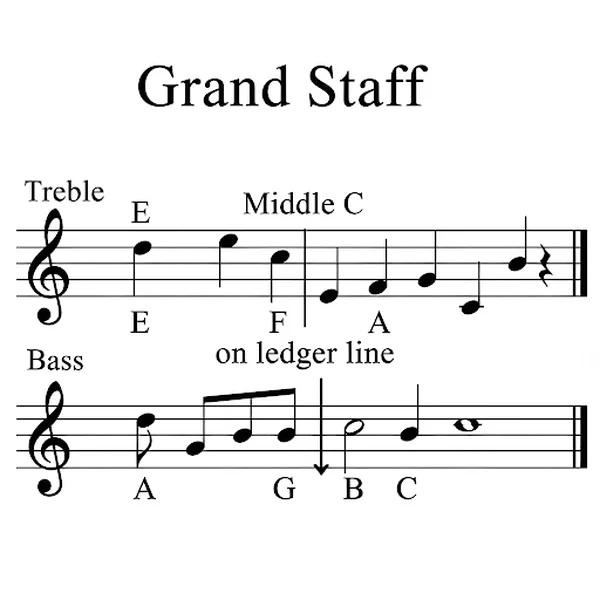पियानो स्टाफ पेपर को समझना: ग्रैंड स्टाफ समझाया गया
पियानो स्टाफ पेपर को पढ़ना सीखना एक नई भाषा को अनलॉक करने जैसा लग सकता है, खासकर जब आप ग्रैंड स्टाफ से मिलते हैं। ग्रैंड स्टाफ क्या है, और यह पियानो संगीत के लिए इतना केंद्रीय क्यों है? यह मार्गदर्शिका पियानो शीट संगीत को सरल बनाने और ग्रैंड स्टाफ की स्पष्ट व्याख्या प्रदान करने का लक्ष्य रखती है, ताकि आप आत्मविश्वास से अपनी संगीत यात्रा शुरू कर सकें। यदि आप सिद्धांत को व्यवहार में लाने के लिए तैयार हैं, तो आप मुफ्त प्रिंट करने योग्य शीट के लिए [हमारे पियानो पेपर] (https://staffpaper.org) का पता लगा सकते हैं।
पियानो संगीत में ग्रैंड स्टाफ क्या है?
तो, ग्रैंड स्टाफ का पियानो संगीत से क्या संबंध है? ग्रैंड स्टाफ वह आधार है जिस पर अधिकांश पियानो संगीत लिखा जाता है। यह विशिष्ट रूप से दो स्टाफ (स्टाफ का बहुवचन), एक दूसरे के ऊपर, बाईं ओर एक ब्रेस द्वारा एक साथ जुड़े हुए हैं। यह संरचना पियानो द्वारा उत्पादित नोटों की विस्तृत श्रृंखला को संकेतित करने के लिए आवश्यक है।

दो स्टाफ: ट्रेबल और बास एक साथ जुड़े हुए
शीर्ष स्टाफ आम तौर पर ट्रेबल क्लेफ़ का उपयोग करता है, और निचला स्टाफ बास क्लेफ़ का उपयोग करता है। ये दो स्टाफ, जब संयुक्त होते हैं, तो पिचों की एक विस्तृत स्पेक्ट्रम का प्रतिनिधित्व करने की अनुमति देते हैं, जो पियानो जैसे वाद्य यंत्र के लिए एकदम सही है जिसका कीबोर्ड व्यापक है। यह प्रणाली पियानोवादकों के लिए एक व्यापक मानचित्र के रूप में ग्रैंड स्टाफ को समझने में मदद करती है।
पियानो संगीत को ग्रैंड स्टाफ की आवश्यकता क्यों है
यह दोहरे स्टाफ प्रणाली, ग्रैंड स्टाफ, पियानो संगीत के लिए इतना महत्वपूर्ण क्यों है? पियानो में 88 कुंजियाँ हैं, जो उच्च और निम्न नोटों की विशाल श्रेणी को कवर करती हैं। एकल स्टाफ लेजर लाइनों (स्टाफ को बढ़ाते हुए उन छोटी रेखाओं) की अत्यधिक संख्या के बिना इस संपूर्ण श्रेणी को संकेतित करने के लिए पर्याप्त नहीं होगा। ग्रैंड स्टाफ इस श्रेणी को बड़े करीने से विभाजित करता है: ट्रेबल स्टाफ आम तौर पर दाहिने हाथ (उच्च पिच) द्वारा बजाए गए नोटों के लिए, और बास स्टाफ बाईं ओर बजाए गए नोटों के लिए (निचले पिच), हालांकि यह एक सामान्य दिशानिर्देश है और भिन्न हो सकता है। यह प्रणाली कीबोर्ड वाद्ययंत्रों के लिए संगीत संकेतन का एक मुख्य भाग है।
क्लेफ़ को समझना: पियानो स्टाफ पेपर पर ट्रेबल क्लेफ़ और बास क्लेफ़
क्लेफ़ को समझना पियानो संगीत को पढ़ने के लिए मौलिक है। प्रत्येक क्लेफ़ स्टाफ पर एक रेखा को एक विशिष्ट पिच प्रदान करता है, जो तब अन्य सभी रेखाओं और रिक्तियों के पिचों को निर्धारित करता है। जब आप पियानो स्टाफ पेपर को देखते हैं, तो आप लगभग हमेशा इन दो प्रमुख प्रतीकों को देखेंगे।

ट्रेबल क्लेफ़ (जी क्लेफ़): उच्च नोटों के लिए
ट्रेबल क्लेफ़, जिसे जी क्लेफ़ के रूप में भी जाना जाता है, वह प्रतीक है जो ऊपरी स्टाफ के नीचे से दूसरी रेखा के चारों ओर घूमता है। यह रेखा मध्य सी के ऊपर जी नोट बन जाती है। ट्रेबल क्लेफ़ का उपयोग उच्च-पिच वाले नोटों को संकेतित करने के लिए किया जाता है। पियानो के लिए ट्रेबल क्लेफ़ क्या है? यह मुख्य रूप से दाहिने हाथ को निर्देशित करता है। कई शुरुआती पियानोवादक इस क्लेफ़ में पियानो नोट्स सीखना शुरू करते हैं।
बास क्लेफ़ (एफ क्लेफ़): निचले नोटों के लिए
बास क्लेफ़, या एफ क्लेफ़, का उपयोग निचले-पिच वाले नोटों के लिए किया जाता है। इसके दो बिंदु निचले स्टाफ के नीचे से चौथी रेखा को पार करते हैं, इस रेखा को मध्य सी के नीचे एफ नोट के रूप में नामित करते हैं। पियानो के लिए बास क्लेफ़ क्या है? यह आम तौर पर बाईं ओर बजाए गए नोटों को इंगित करता है। पियानो संगीत को कुशलतापूर्वक पढ़ने के लिए दोनों क्लेफ़ में महारत हासिल करना महत्वपूर्ण है।
अपने प्रिंट करने योग्य पियानो स्टाफ पेपर पर क्लेफ़ की पहचान करना
जब आप हमारी साइट से [प्रिंट करने योग्य संगीत शीट] (https://staffpaper.org) डाउनलोड करते हैं, तो आप आमतौर पर ट्रेबल और बास क्लेफ़ दोनों के साथ पूर्व-मुद्रित ग्रैंड स्टाफ देखेंगे। इससे आपकी पियानो अभ्यास शीट को तुरंत शुरू करना आसान हो जाता है। इन क्लेफ़ को तुरंत पहचानना आपके पियानो स्टाफ पेपर को नेविगेट करने का पहला कदम है।
ग्रैंड स्टाफ पर नोट्स का पता लगाना: लाइनें, रिक्तियाँ और मध्य सी
एक बार जब आप क्लेफ़ को समझ लेते हैं, तो पियानो संगीत को पढ़ने में अगला कदम ग्रैंड स्टाफ की रेखाओं और रिक्तियों पर नोटों की पहचान करना है। आपको कैसे पता चलेगा कि कौन सा नोट कौन सा है?
ट्रेबल स्टाफ लाइनों और रिक्तियों पर नोट्स
ट्रेबल स्टाफ के लिए, नीचे से ऊपर तक की रेखाएँ हैं E-G-B-D-F ("हर अच्छा लड़का अच्छा काम करता है")। नीचे से ऊपर तक की जगहें हैं F-A-C-E। संगीत सिद्धांत की मूल बातों के लिए इन रेखाओं और रिक्तियों को समझना ग्रैंड स्टाफ के लिए महत्वपूर्ण है।
बास स्टाफ लाइनों और रिक्तियों पर नोट्स
बास स्टाफ के लिए, नीचे से ऊपर तक की रेखाएँ हैं G-B-D-F-A ("अच्छे लड़के हमेशा अच्छा काम करते हैं")। नीचे से ऊपर तक की जगहें हैं A-C-E-G ("सभी गाय घास खाती हैं")। रिक्त संगीत पांडुलिपि पेपर के साथ निरंतर अभ्यास इस ज्ञान को मजबूत करने में मदद करता है।

मध्य सी खोजना: क्लेफ़ के बीच का पुल
मध्य सी पियानो एक महत्वपूर्ण नोट है। ग्रैंड स्टाफ पर, मध्य सी ट्रेबल स्टाफ के ठीक नीचे या बास स्टाफ के ठीक ऊपर एक लेजर लाइन पर स्थित है। यह दो स्टाफ को जोड़ने वाले एक केंद्रीय संदर्भ बिंदु के रूप में कार्य करता है और अक्सर पहले नोटों में से एक होता है जो पियानो के छात्र सीखते हैं।
ग्रैंड स्टाफ पर संगीत को और अधिक प्रभावी ढंग से पढ़ने के लिए सुझाव
ग्रैंड स्टाफ पर संगीत पढ़ने की आपकी क्षमता में सुधार करने में समय और अभ्यास लगता है। पियानो संगीत कैसे पढ़ें? यहाँ कुछ सुझाव दिए गए हैं:
पियानो स्टाफ पेपर पर सरल धुनों के साथ अभ्यास करें
सरल टुकड़ों से शुरुआत करें और अपने पियानो स्टाफ पेपर पर नोटों की सही पहचान करने पर ध्यान केंद्रित करें। जल्दी मत करो; शुरुआत में गति से अधिक सटीकता महत्वपूर्ण है। दैनिक अभ्यास के लिए [मुफ्त स्टाफ पेपर] (https://staffpaper.org) का उपयोग करने से आपकी प्रगति में काफी वृद्धि हो सकती है।
रेखाओं और रिक्तियों के लिए स्मृतिगत उपकरणों का उपयोग करना
स्मृतिगत उपकरण, जैसे पहले उल्लिखित वाक्यांश (जैसे, "हर अच्छा लड़का अच्छा काम करता है"), रेखाओं और रिक्तियों को याद रखने के लिए बहुत मददगार हो सकते हैं।
निरंतर अभ्यास का महत्व
नियमित अभ्यास का कोई विकल्प नहीं है। यहां तक कि छोटे, केंद्रित सत्र दैनिक रूप से असामान्य लंबे समय से अधिक प्रभावी होते हैं। पियानो अभ्यास शीट के साथ निरंतर जुड़ाव पहचान की गति और सटीकता बनाने में मदद करता है।
StaffPaper.org से अपने मुफ्त पियानो स्टाफ पेपर को चुनना और उपयोग करना
अपने अभ्यास का अधिकतम लाभ उठाने के लिए, सही सामग्री होना आवश्यक है। हम विभिन्न प्रकार के मुफ्त स्टाफ पेपर विकल्प प्रदान करते हैं, जिसमें ग्रैंड स्टाफ के लिए पूरी तरह से उपयुक्त पियानो स्टाफ पेपर भी शामिल है।
सही पियानो स्टाफ पेपर लेआउट का चयन करना (जैसे, 10 स्टाफ, 12 स्टाफ)
विचार करें कि आप एक पृष्ठ पर कितना संगीत चाहते हैं। हम विभिन्न संख्या में स्टाफ के साथ लेआउट प्रदान करते हैं, ताकि आप अपनी आवश्यकताओं के अनुसार सबसे उपयुक्त चुन सकें, चाहे वह त्वरित अभ्यास के लिए हो या लंबी रचनाओं के लिए। आप हमारी साइट पर [विभिन्न प्रकार के स्टाफ पेपर] (https://staffpaper.org) पा सकते हैं।
अपना पियानो स्टाफ पेपर पीडीएफ कैसे डाउनलोड और प्रिंट करें
अपना पियानो स्टाफ पेपर पीडीएफ प्राप्त करना आसान है। बस हमारे चयन को ब्राउज़ करें, अपनी पसंद का लेआउट चुनें और इसे तुरंत डाउनलोड करें। हमारे उच्च-गुणवत्ता वाले पीडीएफ आपकी संगीत संकेतन आवश्यकताओं के लिए स्पष्ट मुद्रण सुनिश्चित करते हैं। [अपना पियानो पेपर डाउनलोड करने] (https://staffpaper.org) के लिए तैयार हैं?
अपनी पियानो यात्रा शुरू करें: ग्रैंड स्टाफ को समझना महत्वपूर्ण है
यहाँ समझाया गया ग्रैंड स्टाफ पियानो साक्षरता की रीढ़ बनाता है। जबकि यह शुरू में जटिल लग सकता है, इसे क्लेफ़, रेखाओं और रिक्तियों में तोड़ने से यह प्रबंधनीय हो जाता है। उच्च गुणवत्ता वाले पियानो स्टाफ पेपर का लगातार अभ्यास इसमें महारत हासिल करने की कुंजी है। हम आपको अपने मुफ्त संसाधन डाउनलोड करने और जो आपने सीखा है उसे लागू करना शुरू करने के लिए [हमारी वेबसाइट पर जाने] (https://staffpaper.org) के लिए प्रोत्साहित करते हैं।
पियानो स्टाफ पेपर और ग्रैंड स्टाफ के बारे में आपके प्रश्न का उत्तर दिया गया
यहाँ कुछ सामान्य प्रश्न हैं जो पियानोवादक और संगीत शिक्षार्थी पूछते हैं:
पियानो स्टाफ पेपर को वास्तव में क्या कहा जाता है?
जबकि अक्सर इसे केवल "पियानो स्टाफ पेपर" या "पियानो संगीत पेपर" कहा जाता है, ट्रेबल और बास क्लेफ़ को एक साथ जोड़कर प्रदर्शित विशिष्ट प्रारूप को औपचारिक रूप से ग्रैंड स्टाफ पर लिखे गए संगीत के रूप में जाना जाता है। आप अपने अभ्यास के लिए [यहाँ] (https://staffpaper.org) विभिन्न ग्रैंड स्टाफ पेपर विकल्प पा सकते हैं।
सामान्य पियानो स्टाफ पेपर पर कितनी रेखाएँ होती हैं?
ग्रैंड स्टाफ प्रदर्शित करने वाला विशिष्ट पियानो स्टाफ पेपर दो स्टाफ से मिलकर बनता है, प्रत्येक में पाँच क्षैतिज रेखाएँ होती हैं। इसलिए, कुल मिलाकर, आप पाँच के दो सेटों में समूहीकृत दस रेखाओं को देख रहे हैं, साथ ही उनके बीच की जगह भी। यह ग्रैंड स्टाफ पर संगीत संकेतन के लिए मानक है।
क्या ग्रैंड स्टाफ का उपयोग पियानो के अलावा अन्य वाद्ययंत्रों के लिए किया जाता है?
हाँ, जबकि पियानो के साथ सबसे अधिक जुड़ा हुआ है, ग्रैंड स्टाफ का उपयोग अन्य कीबोर्ड वाद्ययंत्रों जैसे ऑर्गन, हार्पसीकोर्ड और सेलेस्टा के लिए भी किया जाता है। इसका उपयोग कभी-कभी वीणा संगीत के लिए भी किया जाता है। इन वाद्ययंत्रों के लिए भी ग्रैंड स्टाफ को समझने की आवश्यकता है।
मुझे मुफ्त प्रिंट करने योग्य ग्रैंड स्टाफ पेपर कहाँ मिल सकता है?
आप [यहाँ क्लिक करके] (https://staffpaper.org) उच्च-गुणवत्ता, मुफ्त प्रिंट करने योग्य ग्रैंड स्टाफ पेपर पा सकते हैं। हम आपके पियानो अभ्यास शीट और रचना आवश्यकताओं के अनुरूप विभिन्न लेआउट प्रदान करते हैं।